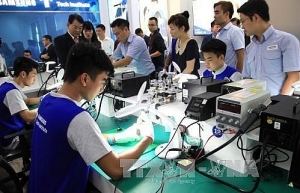Barriers broken down in vocational training
 |
| Photo: Shutterstock |
Hanoi College of Electro Mechanics (HCEM) is one of 45 training institutions that seeks to become a high-quality training school for Vietnam, approaching the advanced training level of the rest of the region and beyond.
The school already boasts many students who have achieved high results in national, ASEAN, and global vocational skills exams. It currently offers training for 20 professions, of which seven key occupations are covered according to high-quality international-standard programmes, with the number of high-quality labourers entering the market standing at over 1,000 people per year.
Despite possessing many achievements and experience in vocational training for more than 50 years, rector Dong Van Ngoc said that HCEM still faces many difficulties in enrolment, despite nowhere near reaching capacity.
“We invest in modern facilities that are not inferior to many leading universities in Vietnam. While universities specialise in research training, vocational training institutions like HCEM focus mainly on practical teaching, so the equipment and books in the classrooms are equipped just like businesses,” said Ngoc.
However, misconceptions about such training remain in this country. “The mindset that a good student must go to university, while vocational training is for students with difficult circumstances and low ability, has been deeply ingrained in the subconscious of many Vietnamese and is a pressing issue for educators,” Ngoc said.
Therefore, eliminating this prejudice and bringing the contributions of such programmes to the right position in the job market is an ongoing challenge for management agencies and establishments.
According to Nguyen Quoc Huy, rector of Bac Ninh College of Electrical Engineering and Construction, vocational education is often closely linked to the needs of businesses, from building programmes and organising training to arranging jobs after graduation. Therefore, most graduates in this type of education often get jobs immediately.
In the northern province of Bac Ninh, one of the localities with the highest concentration of industrial parks and foreign-invested enterprises in Vietnam, the average income of vocational students after graduation is about VND7 million ($300) per month. Students with good skills can reach an income of VND20 million ($870) per month.
“This level of income is commensurate with or even higher than that of many university graduates,” emphasised Huy. “We need to change our perspective, as it’s normal to study well but go on a vocational training course. Those who study well in the direction of skills development should go to such training.”
Vu Truong Giang, deputy chief of office at the Ministry of Labour, Invalids, and Social Affairs, said that the effects of the pandemic still have a great impact on many areas of the job market, and that society’s perception of vocational training may be shifting as a result.
However, in order to achieve more development this year, Giang suggested that schools must connect with businesses to strengthen training orders, and integrate recruitment standards of enterprises into their ongoing courses. There must also be a focus on digital transformation skills.
“We want parents and students to understand that the vocational training ecosystem and other ecosystems are integrated with the goal of creating opportunities for all. Each student should base their decisions on qualifications, passions, and interests and choose the most suitable kind of training as an official path to access better and more sustainable job opportunities in the future,” he said.
Vocational education is increasingly proving effective when meeting the needs of employers and the labour market. According to statistics of the General Directorate of Vocational Training, there are around 670 professions and occupations at college level and almost 900 at intermediate level.
In which, about 80 per cent of graduates have had jobs suitable to their professions and training qualifications or created their own jobs, participating in most fields of the economy. The rate of rural labourers having jobs after training reached 89.3 per cent.
In some occupations such as mechatronics, telecommunications, logistics, tourism, and oil and gas, the vocational skills of Vietnamese workers meet the requirements of foreign-invested enterprises and can take on many complex job positions previously performed by overseas experts.
Unofficial reports from training institutions in Vietnam suggest that the enrolment rate last year at colleges was over 103 per cent, and at intermediate schools the rate reached 104 per cent. Continuing education and other forms may have seen enrolment of more than 10 per cent.
| Dong Van Ngoc, Rector Hanoi College of Electro Mechanics Skills training time and work capacity are significant in vocational education, in which practice is crucial. Vocational education institutions are ready to apply technology to ensure training activities in any situation, including digital transformation of learning and teaching processes, and investment in VR technology or simulation tech to promote distance teaching. We are no exception. During the pandemic, we carried out the same on-site training initiatives as military schools to isolate us from the outside environment. For students who participated in online learning during that time, if there was a shortage of knowledge and skills, they were compensated in meeting output standards. However, training programmes must be shortened to sit alongside the school year. Preliminary assessment results indicate that graduates in 2022 can still integrate into the job market. We also have a job placement policy for students, and those who cannot find a job will be refunded their tuition fees. We also invest in Industry 4.0 technology to meet the needs of labour training for auxiliary technology enterprises in the high-tech field. Pham Vu Quoc Binh, Deputy director general General Directorate of Vocational Training Vocational education had many outstanding achievements in 2022. Enrolment exceeded the set target of about 2.3 million people, equivalent to more than 10 per cent. The awareness of society, especially businesses, about vocational training is increasingly improved. Many businesses have cooperated with training institutions to organise training programmes, while the number of trainees at related institutions participating in the international labour market increasing. Vietnam also won two silver medals at the World Skills Competition last year, demonstrating the increasing quality of vocational institutions. The directions of the National Assembly and the government emphasise the investment of resources and the building of mechanisms to develop vocational education. To achieve this, first of all, it is necessary to build a lifelong learning system in the field of education for the whole society. It is required to raise awareness about related training, improve training quality, and promote activities according to the needs of enterprises, helping trainees access sustainable jobs after graduation with suitable salaries. Another vital factor is the integration of career counselling into the general education curriculum and the vocational training and working process of employees. With good career counselling and guidance, learners will make better choices. Nguyen Duc Luu, Rector Bac Ninh College of Industry Bac Ninh province has a relatively high density of foreign-led enterprises, a well-developed system of vocational training institutions and a vibrant labour market. These institutions here also pay great attention to coordinating with media to change people’s thinking and perception about vocational education, as well as its value in the labour market. Although each institution will have different admission policies, we all take full advantage of social networks to spread information to the community, connecting those in need with the communication channels of institutions. There are many students who finish university and cannot find a job, so the education and admissions counselling industry need to give more advice on suitable subjects for each level of study and each training scheme, such as advice on choosing attractive professions. The work of counselling and streamlining the abilities of students also needs attention to avoid the situation of people studying in many schools at the same time, but not being able to get a job. Vocational institutions should also cooperate with the Ministry of Education and Training to communicate to parents and young people appropriately. |
 | Vocational training not to be overshadowed by higher education Sharing about Malaysia's experiences in overcoming the middle-income trap, Datuk K. Yogeevaran Kumaraguru, former Secretary-General of the Ministry of Plantation Industry and Commodities, Malaysia said at the Vietnam Reform and Development Forum (VRDF) 2019 that Malaysia made a mistake by only focusing on higher education while forgetting vocational training, and cautioned Vietnam against making the same mistake. |
 | Vocational schools, colleges expect 80 percent of graduates to find jobs More than 80 percent of graduates at most colleges and vocational training schools in HCM City this year have found jobs, according to the city’s Department of Labour, Invalids and Social Affairs. |
What the stars mean:
★ Poor ★ ★ Promising ★★★ Good ★★★★ Very good ★★★★★ Exceptional
Related Contents
Latest News
More News
- Protect what’s next: towards a future free from meningococcal group B disease (December 05, 2025 | 18:00)
- New ILO report offers policy recommendations for disability inclusion (December 04, 2025 | 15:18)
- Maternal job loss may affect children’s mental health, research shows (December 03, 2025 | 19:11)
- Women lead Vietnam’s shift to climate-resilient agriculture (December 03, 2025 | 19:10)
- Experts highlight unpaid care work as key barrier to gender equality (December 03, 2025 | 15:15)
- Opportunities and inequalities for women workers in Vietnam's garment industry (December 03, 2025 | 09:00)
- Vietjet flights carry love to devastated central region (November 28, 2025 | 11:35)
- New initiative to boost the fight against domestic violence (November 26, 2025 | 10:00)
- South Korea funds IOM relief for Vietnam’s typhoon-affected communities (November 24, 2025 | 15:33)
- AI and human-centred values set to shape the future of HR in Vietnam (November 21, 2025 | 18:04)

 Tag:
Tag:





















 Mobile Version
Mobile Version